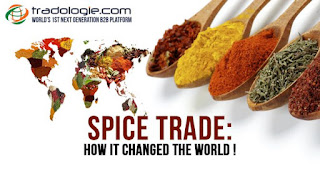Spice Trade: How It Changed the World
Spices were not only used as
flavourings or food preservatives, but they were also used in religious
ceremonies, cosmetics and embalming fluids, and even medicines and alternative
remedies since ages (for example, cinnamon was once thought to cure the
plague). This made spices highly sought after by people all over the world, and
many wanted to get their hands on them at any cost. The result? The Spice Trade was born!
Brief
History of the Spice Route
The
history of trade is a bit complex, and it’s not something that you can simply
explain with a single example. Still, it is important to understand how
important spices were to trade in ancient times. A vital part of early
commerce, spice trading helped shape our modern world by introducing new forms
of government and diplomacy. In fact, many of our current forms of government
came out of their efforts to control land and find new means for increasing
revenue.
Spices
in Greece and Rome
The
western world’s trade and use of spices in ancient Greece and Rome was very different
from that of other civilizations in which they mainly imported spices as opposed to producing them
locally. Because of their focus on importing, bulk spices (such as pepper)
were more important to Greek and Roman traders than precious or rare spices
(such as cinnamon), while they often had only scant knowledge about their
origins. The Greeks, for example, seemed not to have known precisely where
pepper came from, referring to it simply as India-rubber or land-pepper. In
fact, there is evidence that much of what we know about spice trade in ancient Greece
comes from later writers such as Pliny and Dioscorides.
Spices
in the Byzantine Empire
Spices
were an important source of income for Byzantium. As a result, overland trade
routes would often be altered to pass through Byzantine territory. This led to
improvements in transportation and shipping, which in turn made goods cheaper
for everyone involved. The Silk Road, for example, took on new importance as
trade with Byzantium increased – after all, what merchant wouldn’t want to get
access to those much-desired bulk
spices?
Revival
of Spice Trade Under Islam
By
622 A.D., Arabian traders had already established a trade route that connected
East Africa to India via Egypt, Syria and Turkey. This involved shipping bulk spices in
exchange for gold. One of these spices was black pepper, which has long been
used for seasoning food and medicine. As part of their cultural preservation
efforts, Muslims outlawed alcohol consumption during their rule in India from
1206-1526 A.D. In order to flavor food without using wine or beer, people
started using black pepper as an alternative seasoning. The spice’s popularity
soared as a result and exports from Kerala –the main source of black pepper–
peaked at over 150 tons in 1513 A.D., accounting for about 75% of world trade
at that time!
Fall
of Constantinople – Rediscovery of Routes by Europe
In
1453, Constantinople fell to Mehmet II after a five-week siege. The capture of
the great city by a Turkish sultan was deeply shocking to Christendom, and was
viewed as both a cataclysmic event in itself and also one that presaged further
advances against Christendom’s eastern flank.
Age
of Discovery – Diffusion in Europe
These
discoveries in India and East Asia were crucial to European merchants, who were
now able to supply and stock their own colonies in Asia with a fresh supply of
goods, such as spices. The new Age of Discovery began when Portuguese and
Spanish explorers sailed along West Africa’s coast (1400s) and rounded Africa
on its southern tip (1500s). Portuguese explorers reached Asia by sea in 1498;
Vasco da Gama travelled along the Cape of Good Hope to Calicut (India), which
was under Ottoman Empire control. In 1500, Spanish explorer Ferdinand Magellan
journeyed across oceans from Spain to South America and back again, proving
that it was possible for ships to cross oceans.
Colonialism
– New Way to Export Spices
Before
we can discuss how colonialism changed India’s spice trade, we have to first
understand why spices are so important. In essence, it was cheaper for Europe
to buy their spices from India than it was to produce them domestically. For
example, in France it would cost about 50 livres for a pound of cinnamon;
however, in India at that time, one could purchase three pounds of cinnamon for
only 2 livres.
Modern
Use of Spices
With
the vast presence of Indian spices online, almost anyone can cook like a
professional. The usage of spices to liven up otherwise boring dishes is as old
as mankind itself. From Asia and Africa to Europe and America, every culture
has some sort of spice tradition that brings added flavour to our meals. And
while professionals still use many exotic flavours in their cooking, they’re
not quite as hard to come by as they once were.
Final
Thoughts on the Spice Trade
The
impact of globalized spice
trade was
truly revolutionary. While spices may seem like a small thing, they had lasting
impacts on world history. For example, before Columbus’ voyage to India and
China, Venice was already one of Europe’s largest markets for spices and in
particular pepper. On their return from Asia after bringing back large cargoes
of pepper, Portuguese merchants flooded Venice with cheap Indian pepper so that
even local Italian production couldn’t compete. This directly led to Venetian
manufacturers moving away from silk and into spices as a way to build their
wealth. In short, you can’t properly understand Europe’s Renaissance without
looking at its spice trade with Asia.
Tradologie.com has made modern spice trade more feasible and easily accessible. It enables verified global bulk buyers to procure high quality spices directly from verified global bulk sellers without a phone call or an email.
Original Source: https://blog.tradologie.com/spice-trade-how-it-changed-the-world/




Comments
Post a Comment